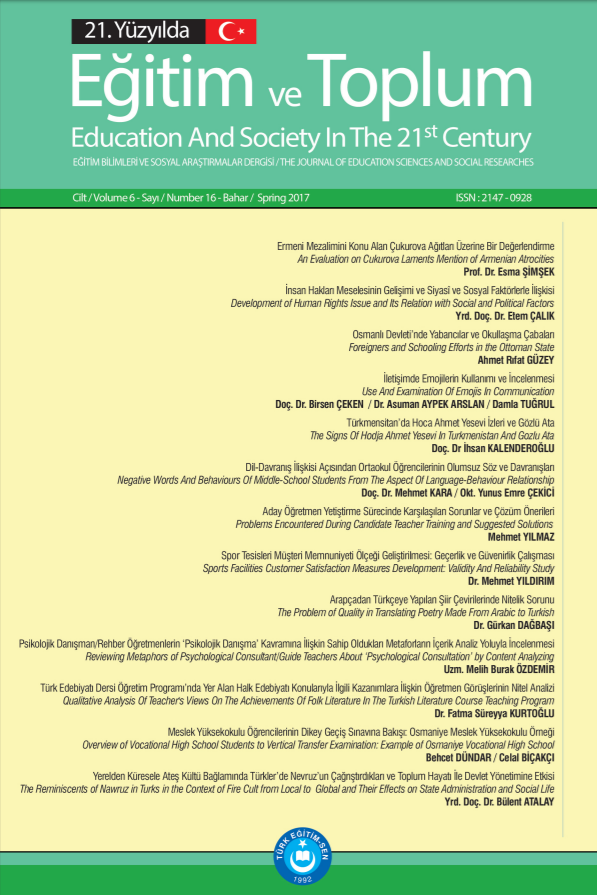GÖRSEL SANATLAR EĞİTİMİNDE TEKNOLOJİ ENTEGRASYONU VE TEKNOLOJİK PEDAGOJİK İÇERİK BİLGİSİ MODELİ
İçinde bulunduğumuz yüzyılda teknoloji her geçen gün gelişmekte ve bu gelişimini ileri noktalara taşımaktadır. Bu nedenle teknoloji kullanımı tüm dünyada her gün biraz daha önem kazanmakta ve artmaktadır. Günümüzde toplumların çağdaşlaşması ve gelişmesinde bilimsel ve teknolojik bilgi oldukça önemli bir yer edinmektedir. Bilim ve teknolojinin içinde bulunduğu bilgi bireylerin merak duygularının ve doğayı anlama isteklerinin sonucu olarak meydana gelmektedir (Timur & Taşar, 2011). Teknolojinin gelişimi en çok eğitimi ve eğitimin tüm alanlarını etkileyerek, şekillendirmektedir. Görsel Sanatlar eğitimi, eğitimdeki tüm alanlar içerisinde teknolojideki gelişmelerden en çok etkilen branşlardan biri olarak yer almaktadır. Gelişen teknoloji Görsel Sanatlar eğitimi alanında, sanat eğitimine farklı bakış açıları ile bakma fırsatı yaratmakta, sanat eğitiminde yeni yöntem ve teknikler geliştirmekte ve bu sayede günlük hayatımızın en önemli parçalarından biri olan teknoloji, sanat eğitimi alanında da önemli bir yer etmektedir. Teknolojideki gelişmeler sadece okullarda verilen sanat eğitimini şekillendirmekle kalmamakta aynı zamanda Görsel Sanatlar öğretmen adaylarının lisans eğitimleri sürecinde de oldukça önemli bir rol oynamaktadır. Teknolojinin sanat eğitimi içerisindeki bu gelişimi ve katkılarından dolayı öğretmenlerin yetiştirilme sürecinde teknolojiyi sınıf ortamında kullanmaları gerekli bir durum haline gelmiştir. Bu amaçla öğretmen adaylarına lisans eğitimi sürecinde 1998 yılından itibaren Öğretim Teknolojileri ve Materyal Tasarımı dersi zorunlu ders olarak verilmeye başlanmıştır (Kaya & Samancı 2010). Teknolojinin gelişimi beraberinde kolaylıklar getirmekle birlikte ve yeni bir kavram olan teknolojinin eğitime entegrasyonu kavramını ortaya çıkarmıştır. Bu amaçla teknolojinin eğime entegrasyonu ile ilgili birçok farklı yaklaşım ortaya çıkmıştır. Teknolojik Pedagojik İçerik Bilgisi (TPİB) teknolojinin eğitime entegrasyonunu ele alan en kapsamlı ve en etkili yaklaşımlardan biri olarak yer almaktadır.
Anahtar Kelimeler:
Teknoloji, teknoloji entegrasyonu, TPİB
Technology Integration And Technological Pedagogic Content Knowledge Model In Visual Arts Education
In the century we live in, technology is developing day by day and it carries this development forward. For this reason, the use of technology is gaining more importance and increasing day by day all over the world. Today, scientific and technological knowledge has a very important place in the modernization and development of societies. The knowledge of science and technology is formed as a result of the curiosity of individuals and their desire to understand nature (Timur & Taşar, 2011). The development of technology mostly affects and shapes education and all areas of education. Visual Arts education is one of the branches most affected by the developments in technology among all fields of education. Developing technology in the field of Visual Arts education creates the opportunity to look at art education from different perspectives, develops new methods and techniques in art education, and thus technology, which is one of the most important parts of our daily life, has an important place in the field of art education as well. Developments in technology not only shape the art education given in schools, but also play a very important role in the undergraduate education process of visual arts teacher candidates. Due to this development and contribution of technology in art education, it has become a necessity for teachers to use technology in the classroom environment during the training process. For this purpose, the Instructional Technologies and Material Design course has been given as a compulsory course to teacher candidates since 1998 during the undergraduate education process (Kaya & Samancı 2010). The development of technology brings with it conveniences and it has revealed the concept of integration of technology into education, which is a new concept. For this purpose, many different approaches have emerged regarding the integration of technology into the slope. Technological Pedagogical Content Knowledge (TPACK) is one of the most comprehensive and effective approaches to the integration of technology into education.
Keywords:
Technology, technology integration, TPACK,
___
- AYAYDIN, Abdullah, (2010), “Temel Tasarım Eğitiminde Bilgisayar Teknolojisinin Gerekliliği ve Geleceği”, Dicle Üniversitesi Ziya Gökalp Eğitim Fakültesi Dergisi, XV, 2010: 52-62.
- AYTEPE, Betül, (2011), “Bilgisayarlı Numerik Kontrol (CNC) Robotların Seramik ve Grafik Eğitiminde Tasarım Aracı Olarak Kullanımı”, Nevşehir Üniversitesi Sosyal Bilimler Enstitüsü Dergisi, I, 2011: 239-253.
- BİLİRDÖNMEZ, Köksal, KARABULUT, Necmettin, (2016), “Sanat Eğitimi Süreç Ve Kuramları”, Ekev Akademi Dergisi, 0, 65: 343-355.
- BORA, Mücahit, (2018), “Görsel Sanatlar Eğitiminde Bilgisayar Teknolojisinden Yararlanma Olanakları”, İdil, VII, 49: 1177-1189.
- DEMİRASLAN, Yasemin, & USLUEL, Yasemin, (2005), “Bilgi ve iletişim teknolojilerinin öğrenme öğretme sürecine entegrasyonunda öğretmenlerin durumu”, The Turkish Online Journal of Educational Techonology (TOJET), IV,15: 109-113.
- DİKMEN, Cemal Hakan & DEMİRER, Veysel, (2016), “Öğretmenlerin Teknoloji Entegrasyonuna Yönelik Davranışlarını Etkileyen Değişkenlerin İncelenmesi”, İnönü Üniversitesi Eğitim Fakültesi Dergisi, XVII, 3: 153-167.
- DOLUNAY, Ahmet, (2016), “Teknolojinin Görsel Sanatlar Ve Sanat Eğitimine Katkısı”, Uluslararası Sosyal Araştırmalar Dergisi, IX, 42: 1208-1213.
- HEW, Khe, Foon, & BRUSH, Thomas, (2007), “Integrating technology into K-12 teaching and learning: Current knowledge gaps and recommendations for future research”, Educational Technology Research and Development, LV, 3: 223-252.
- HİÇYILMAZ, Yahya, (2018), “Görsel Sanatlar Öğretmen Adaylarının Teknolojik Pedagojik İçerik Bilgisi Öz Yeterlikleri”, (Doktora Tezi). Ondokuz Mayıs Üniversitesi Eğitim Bilimleri Enstitüsü; Samsun.
- KHAN, Md Shahadat Hossain Khan, (2014), “A model for integrating ICT into teacher training programs in Bangladesh based on TPCK”, International Journal of Education and Development using Information and Communication Technology (IJEDICT), X, 3: 21-31.
- Kaya. Sağlam, Yasemin, (2019), “Öğretmen Adaylarının Teknopedagojik Eğitim Yeterlikleri Ve Öğretmen Öz Yeterliklerinin Çeşitli Değişkenler Bağlamında İncelenmesi”, Kuramsal Eğitimbilim Dergisi, XII, 1: 185-204.
- ISSN: 2147-0928
- Yayın Aralığı: Yılda 3 Sayı
- Başlangıç: 2012
- Yayıncı: Türk Eğitim-Sen
Sayıdaki Diğer Makaleler
HAKİKAT VE ETİK BAĞLAMINDA PRAGMATİZM ve EĞİTİM
SOSYAL BELEDİYECİLİK ÇERÇEVESİNDE SOSYAL YARDIM VE HİZMET
ANİMASYONUN EĞİTİMDE KULLANIMI VE DEĞERLERİ AKTARMADAKİ ROLÜ
Güzel Sanatlar Eğitimi Öğretmen Adaylarının Ekonomik Kaygılarına İlişkin Bir İnceleme
SAKIZ ADASI’NDA AZINLIK VE YABANCI OKULLARDA EĞİTİM
Sınıf Öğretmenlerinin Beden Eğitimi ve Oyun Dersine Yönelik Fiziksel Okuryazarlık Algıları*
